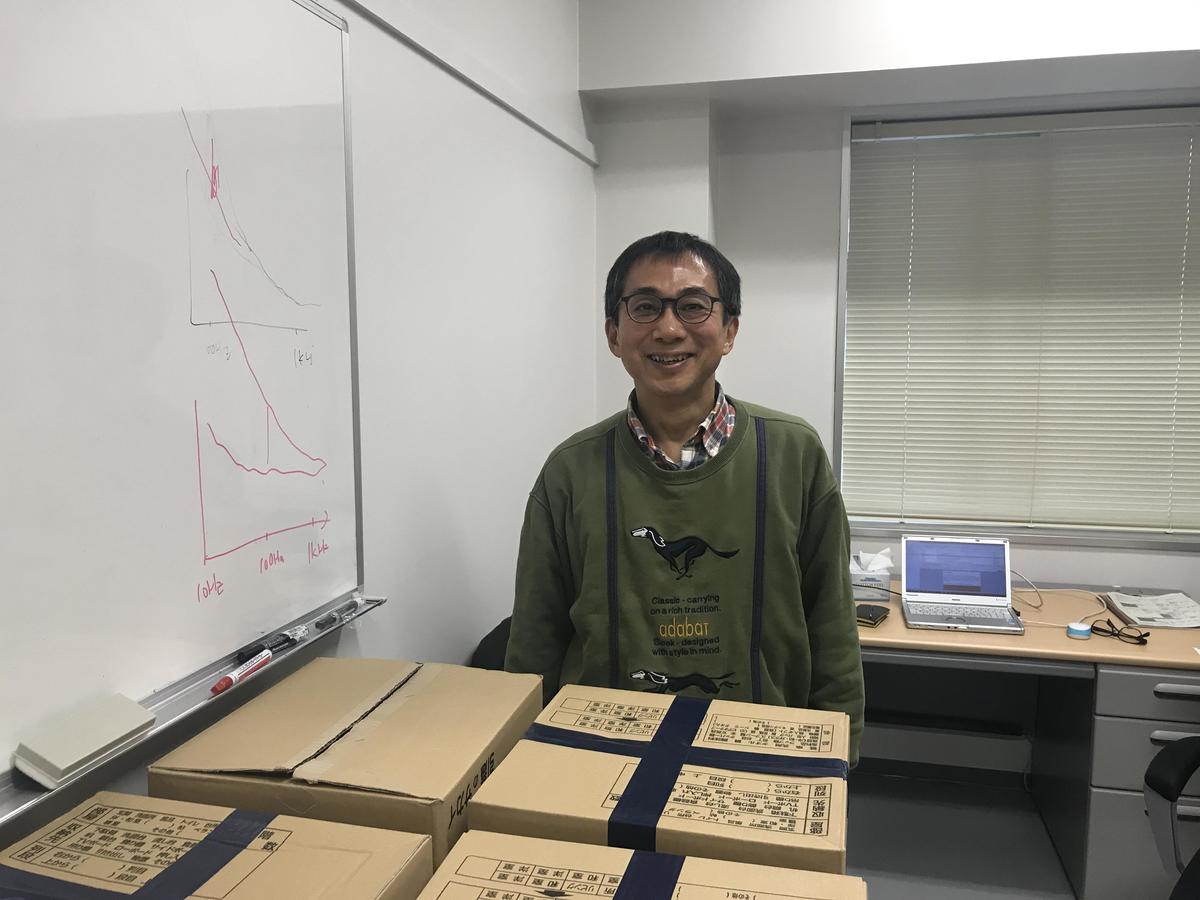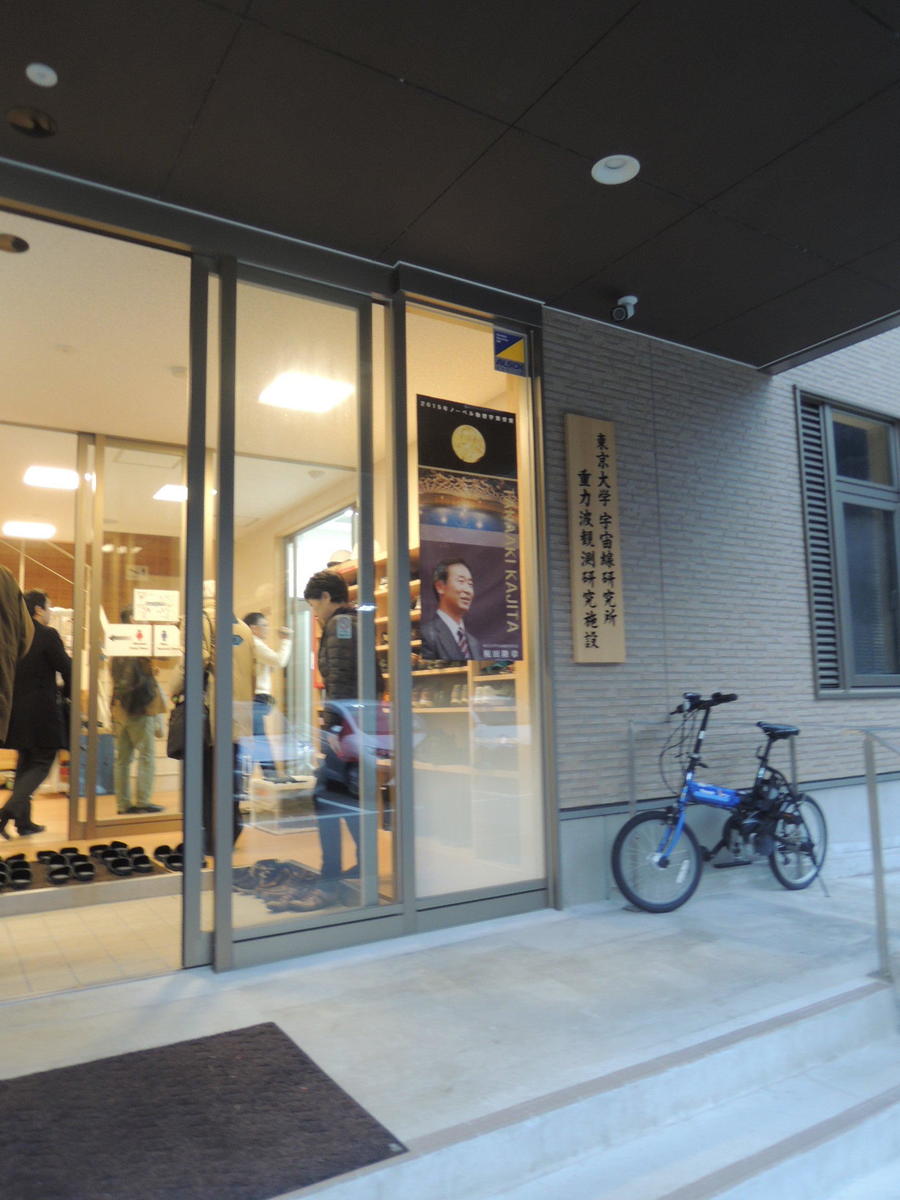January 17, 2018
The Hero of Gravitational Waves Comes to Meidai
The last fall, news that American scientists were awarded the Nobel Prize in Physics for capturing the gravitational waves for the first time was received with much excitement on these shores too. One of the names the US scientists cited as a contributor to their breakthrough achievement was Professor Seiji Kawamura from the Institute for Cosmic Ray Research at the University of Tokyo. Kawamura is also a key member of the KAGRA Large-scale Cryogenic Gravitational Wave Telescope project. KAGRA may have been beaten by the US team to the "world's first" accolade, but with observations due to start next year, it will soon be at the forefront of the nascent field of gravitational-wave astronomy.
The images of Kawamura on news programs being interviewed at KAGRA may still be fresh in our minds, but in fact he left KAGRA in mid-December - to join Nagoya University as Professor of Physics.
I was amazed to hear this news, and rather puzzled: what has brought him to Nagoya?
 Professor Seiji Kawamura in his laboratory
Professor Seiji Kawamura in his laboratory
"I want to see the very moment of the birth of the universe."
When I visited Kawamura in his new laboratory, still full of unopened cardboard boxes stacked high, and posed the question, he answered without hesitation.
"Is it possible here?" To my second question, he immediately answered, "Sure, I came to Nagoya for the purpose."
At 59, he has six years of research life left before the official retirement age. He wants to spend those years focusing entirely on his quest to see the moment the universe began. When he responded to the recruitment advertisement for professorship and came to the interview, he said that same thing - that he wanted to see the beginning of the universe. "I've got the job, so I assume they are happy for me to do that," says Kawamura.
Apparently, he had been looking for a post where he would be allowed to pursue his dream and applied to other institutions that were recruiting, but Nagoya University was the only one that said yes. Universities are going through hard times everywhere, and he guesses that venturing into the new, emerging field of gravitational wave research was probably considered too much of a risk. He did not expect Meidai to be any different. "I am so grateful that they were willing to take that challenge ," he says. And it's not even a fixed-term "Designated Professor" post. Hiring him as a fully tenured professor must have been a brave move for the university.
"I will reach the ripe age of 60 this year - I concede I may be a little strange to be so full of dreams at this point in my life."
His eyes twinkled like a little boy's as he spoke, full of excitement.
And it was when he was a boy, growing up in Kochi, that his fascination with the universe began. He remembers one particular night when he was suddenly gripped by anxiety and felt that everything around him seemed uncertain. "There's nothing to fear as long as there's the universe out there," he told himself, and that thought comforted him enough that he was finally able to sleep. He cannot explain why, but somehow he felt then that the universe was the "mightiest stronghold" in existence.
His path to a life of research was not straight; he ended up repeating his postgraduate studies but was eventually awarded his doctorate from the University of Tokyo Graduate School in 1989 for his research into the detection of gravitational waves. This was his first step towards conquering the mighty universe. He then went to the California Institute of Technology, where he tackled the problem of noise interferences in the prototype of the Laser Interferometer Gravitational-Wave Observatory, or LIGO - the project that eventually led to the Nobel Prize-winning achievement. Kawamura succeeded in cutting the noise to one-thousandth of the original level and was praised as an instant hero. When he faced an early return to Japan after the scholarship money of 2.2 million yen, which had to cover the cost of travel as well as his stay at Caltech with his new bride, ran out after half a year, his laboratory boss hired him as a staff member. It was a post normally reserved for lab members who had completed two three-year terms as postdoctoral researcher, but they were not going to let the hero of the team leave so soon. Kawamura worked to refine noise proofing further and made the LIGO prototype the best in the world, leapfrogging rival observatories in Germany and the UK. This achievement won the funding for the full-scale version of LIGO, which was to be 100 times larger than the prototype. Doctor Kip Thorne of Caltech, one of the Nobel Prize winners, praises Kawamura, the noise hunter who made a massive improvement in the facility's sensitivity, as "a key contributor to LIGO's success." In the end, Kawamura spent seven years on LIGO and returned to Japan in 1997. It was time for him to join a project to build a gravitational wave observatory in Japan.
 Entrance to the KAGRA Observatory at the University of Tokyo's Institute for Cosmic Ray Research in Hida City, Gifu Prefecture, to which Kawamura commuted for many years. The man pictured on the poster welcoming visitors is Takaaki Kajita, Director of the
Entrance to the KAGRA Observatory at the University of Tokyo's Institute for Cosmic Ray Research in Hida City, Gifu Prefecture, to which Kawamura commuted for many years. The man pictured on the poster welcoming visitors is Takaaki Kajita, Director of the
But what have gravitational waves go to do with the mighty universe and, importantly, its birth?
Let's start with a more basic question: what are gravitational waves? Kawamura has written a book that bears this very question as its title. Illustrated by his son, artist Sora, the pocket book is an entertaining take on the question, with Einstein depicted in a rather unflattering belly wrap. This was apparently done as a nod to the Papa character from the popular anime series The Genius Bakabon, and it was Einstein who predicted the existence of gravitational waves through his general theory of relativity in 1916. Put simply, gravitational waves are ripples that spread through the fabric of space when gravity causes it to warp. It was exactly 100 years after Einstein made his prediction that the US team made its first observation of this phenomenon. The homework given to the world by the towering genius was finally answered after 100 years, and a new science of gravitational wave astronomy was born, joining light, radio wave, x-ray and other forms of observational astronomy. This was a groundbreaking achievement that everyone thought would earn a Nobel Prize, and that's exactly what happened.
The homework has taken such a long time to accomplish because gravitational waves are extremely faint and incredibly difficult to detect. Kawamura's aforementioned book explains that, for example, the spacing-warping effect of gravitational waves arriving from a faraway galaxy has on the Earth is so small that it would change the distance between the Earth and the Sun only by the width of a hydrogen atom. The book is subtitled "Einstein plays melodies from outer space." This alludes to the fact that, unlike electromagnetic radiation (such as visible light, radio waves and x-rays), which is detected by sight, gravitational waves are ripples that need to be observed by hearing. To see faint electromagnetic radiation you use telescopes, which can be thought of as a super-sensitive pair of eyeglasses. To hear faint gravitational waves, what you need is an ultra-sensitive pair of hearing aids. If you imagine wearing hearing aids to catch really faint melodies coming from outer space, you can begin to understand the critical importance of noise elimination. You cannot hear gravitational waves until every conceivable type of noise is removed as thoroughly as possible. Kawamura recalls hunting for the source of a noise and eventually tracing it to a single Post-It sheet.
A gravitational wave detector consists of two orthogonal arms - each as long as 4 kilometers in the case of LIGO. These two arms are vacuum tubes through which a laser beam is sent. The idea is to "listen" to gravitational waves indirectly by catching the changes they cause to the laser beam. KAGRA has shorter arms than LIGO's at 3 kilometers, but various measures have been taken to increase its sensitivity. For example, the entire observatory is placed underground in the Kamioka mines where the detector is less likely to be affected by vibrations, and the mirrors used to reflect laser beams are cooled to -253°C
But why gravitational waves? That's because light allows you to see the universe only back to 380,000 years after its birth. Before that point in time, light could not travel straight as the space was full of high-energy particles flying around. It took 380,000 years for the universe to clear - through a phenomenon called "recombination" - allowing light to reach the Earth. Light from that time has already been observed, and it shows that the universe was a giant fireball in its infancy.
The beginning of the universe Kawamura wants to see goes back far beyond this fireball universe, almost to the moment of its birth. Or 10-35 or 10-34 (that's 33 or 34 zeros after the decimal point) seconds after it birth to be precise. The timescale is mind-boggling, but it is thought that this newly born universe was already sending out gravitational waves. If you can catch these waves, then you can learn about the universe at its very beginning.
Of course, capturing the gravitational waves from that point in time must be an incredibly difficult task - finding a needle in a haystack would be a child's play compared to that. Still, with the first ever observation achieved, we are one step closer to the beginning of time. That's why Kawamura was not disappointed at all that other people got there first; he was "100% euphoric," skipping around in delight for days after hearing the news, he says.
And it was around that time that he started thinking about moving on.
Until then, he was going to see KAGRA through to its completion and wait for its first detection of gravitational waves before going back to his holy grail of seeing the beginning of the universe. But now he was beginning to think about the limited time he had left and felt he could be a little more selfish about how to spend it.
After returning from the US, Kawamura worked at the National Astronomical Observatory of Japan on its 300 meter-armed gravitational wave telescope TAMA300. In 2000, it achieved the then highest sensitivity in the world, overtaking its US rival. In 2001, he embarked with like-minded colleagues on a new project to build DECIGO, a space-based gravitational wave observatory. As he worked on these projects, he became certain that it was his destiny to dedicate his life to seeing the beginning of the universe. When the KAGRA project was given funding in 2010, it was decided that all gravitational wave research teams across Japan should come together and focus on KAGRA. The responsibility of Kawamura the noise hunter, who was appointed the leader of the team tasked with the job of achieving the target sensitivity level, was immense. His hope of using spare time in evenings and on weekends to pursue his own interests never materialized. He spent all his waking hours on KAGRA, devoting 200% of his energy, and still he could hardly get through 40% of his to-do list. Time slipped by as his own themes sat gathering dust.
A chance meeting at a co-op shop on the University of Tokyo's Kashiwa Campus with an old acquaintance, Naoshi Sugiyama, dean of the School of Science at Nagoya University, changed all that. He had already been looking for a new job for some time then, but without success with advertised posts. Sugiyama told him that his School was recruiting for a professor in the field of high-energy physics. This was to fill a post vacated by a professor in x-ray astronomy. Japan leads the world in x-ray research, and Meidai is renowned as its mecca. Although gravitational wave research was technically within the scope of the job, Kawamura was not hopeful of getting the job with his unorthodox specialism. In the US, more and more institutions are creating gravitational wave research posts, there are hardly any in Japan; even young, up and coming researchers are struggling to find a post.
Sugiyama explains that he always looks across a wide range of research fields and seeks to hire the most active people. Nagoya University has a fine tradition of combining the making of tangible things and cutting-edge science, and an experimentalist like Kawamura was an ideal person. Although discussions among physics class members did highlight his grand old age of nearly 60 as a concern, they made a bold decision to hire Kawamura in the hope that he would be able to sow seeds for the future in the next six years. Sugiyama had always been impressed by Kawamura's bouncing energy and is sure that Kawamura would be a good inspiration to students.
We have up-and-coming researchers in their 30s are promoted to professorship on one hand, while a veteran with a big dream arrives from an unorthodox field of study on the other hand; you could say that this typifies the free and bold ways in which the Nagoya University School of Science operates.
Although initially surprised by the news of Kawamura's departure to Meidai, his boss, Takaaki Kajita, Director of the Institute for Cosmic Ray Research at the University of Tokyo, was understanding of his reasons and gave him a full blessing.
What are his plans for the next six years at Meidai?
The first on the list is the DECIGO project. He had to move away from the ambitious plan to build the space-based gravitational wave observatory as KAGRA became an all-consuming priority. The plan involves three satellites positioned in a triangular formation, creating a mega-observatory with arms as long as 1000 kilometers. If everything works as it should, it will be capable of receiving gravitational wave from the beginning of the universe. It should also be able to verify the occurrence of "inflation," an exponential expansion of space preceding the Big Bang, a theory proposed by Emeritus Professor Katsuhiko Sato of the University of Tokyo and Professor Alan Guth of MIT Center for Theoretical Physics. Kawamura wants to conduct research to develop instrumentation and conduct foundational experiments. Not that it will be easy - with an estimated price tag of at least 100 billion yen on top of the technological challenges to be overcome, it would take many years, and international efforts, to bring DECIGO into reality. Kawamura's ambition, nevertheless, is to go where nobody has gone before and aim high.
He plans to devote 60-70% of his time to this project and spend the remaining 30-40% on looking into new ways of observing gravitational waves from the ground. He hopes to achieve results in a few years, a decade at most, and says he already has a few ideas to work on.
Although he had been to Meidai a few times before to give seminars and was impressed by its free atmosphere, he had no previous ties with Nagoya. However, since his move in December, he has fallen in love with the city, which to him is not too big, not too small, just right. He has already bought an apartment and is very much here to stay for good.
Welcome to Nagoya University, Professor Kawamura - all the best with the pursuit of your big dream.

 Subscribe to RSS
Subscribe to RSS